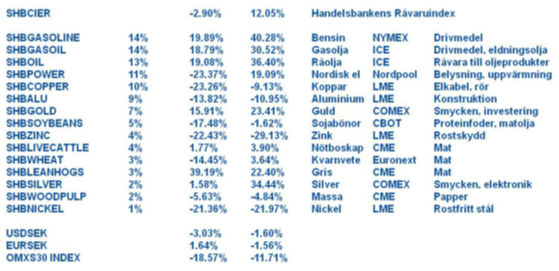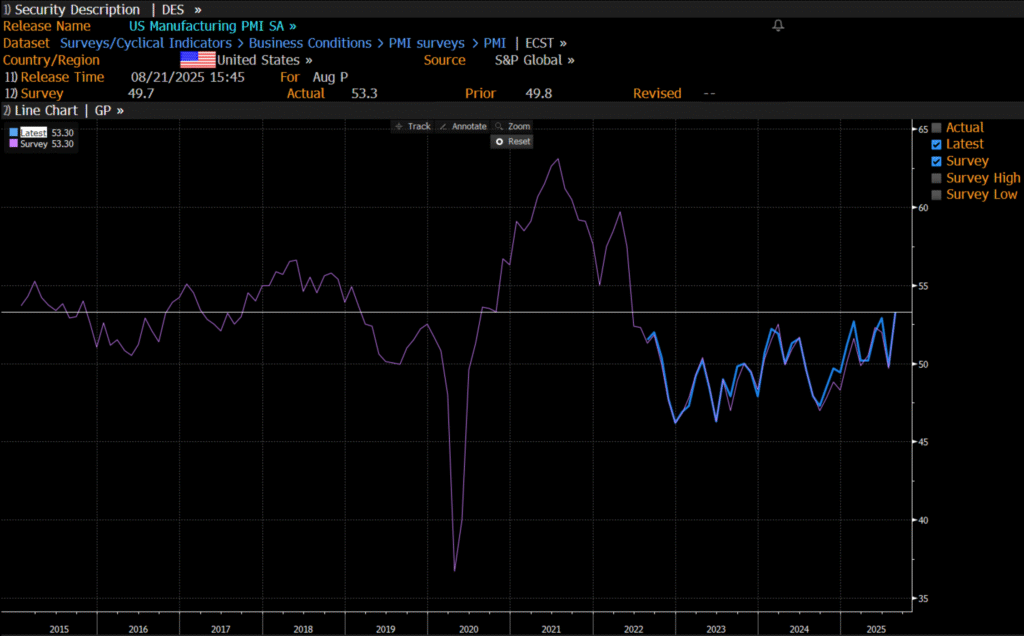Analys
SHB Råvarubrevet 22 oktober 2011
 Vårt Råvaruindex backade med någon procentenhet under veckan men marknaden fann stöd och riskaptiten tilltog efter förhoppningar om att de europeiska ledarna närmar sig en lösning på skuldkrisen samtidigt som Fed indikerade ett möjligt QE3. Kraftigt fall på råoljelagren samtidigt som Libyens oljeproduktion börjar återhämta sig. Gaddafi´s död påskyndar tidsplanen kring oljeproduktionen något men vi tror att uppstart av oljefält och reparationer kommer att ta mycket tid och kraft. Detta bör upprätthålla oljemarknaden något. Statoil meddelade i slutet av veckan att fyndigheten vid Aldus Major South i Nordsjön kan vara en av de största i norsk historia. I övrigt var det kraftiga fall på metaller men marknaderna återhämtade delar av rörelsen mot slutet av veckan.
Vårt Råvaruindex backade med någon procentenhet under veckan men marknaden fann stöd och riskaptiten tilltog efter förhoppningar om att de europeiska ledarna närmar sig en lösning på skuldkrisen samtidigt som Fed indikerade ett möjligt QE3. Kraftigt fall på råoljelagren samtidigt som Libyens oljeproduktion börjar återhämta sig. Gaddafi´s död påskyndar tidsplanen kring oljeproduktionen något men vi tror att uppstart av oljefält och reparationer kommer att ta mycket tid och kraft. Detta bör upprätthålla oljemarknaden något. Statoil meddelade i slutet av veckan att fyndigheten vid Aldus Major South i Nordsjön kan vara en av de största i norsk historia. I övrigt var det kraftiga fall på metaller men marknaderna återhämtade delar av rörelsen mot slutet av veckan.
Det är makroekonomisk oro som styr råvarumarknaden just nu och det är väl ingen överraskning att marknaden förväntar sig mycket långsam tillväxt i Europa, mycket långsam tillväxt i USA och avtagande tillväxt i Kina. Detta har inneburit att en stor del av analytikerkåren har reviderat ned sina prognoser på framför allt metaller. Vi har dock aldrig sett en sådan delad analytikerkår eftersom potentialen för dominoeffekt från enskilda händelser är mycket stor och ökar risken. På Koppar exempelvis pekar prognoserna på allt mellan 7,500 dollar och 10,500 dollar för den kommande 24 månaders perioden.
En hel del osäkerhet och en marknad som anpassat till en kraftig volatilitet kommer naturligtvis bjuda på möjligheter att komma in i råvarumarknaden på gynnsamma nivåer. Det är därför viktigt att belysa en längre placeringshorisont och råvaror ur ett diversifieringsperspektiv. Vi har studerat under vilka perioder sedan 1995 man INTE hade uppnått en lägre risk genom att inkludera råvaror i portföljen. Föga förvånande så har ett inkluderande av råvaror i sparportföljen under samtliga kvartal under denna period lett till en lägre risk. Med andra ord, det har undantagslöst förbättrat den riskjusterade avkastningen, det som är det absolut viktigaste sättet att generera avkastning.
Om vi då ser till det längre perspektivet kan vi inte komma runt det faktum att efterfrågan växer på en ändlig resurs. Om vi väljer att bryta ner vårt råvaruindex i underkomponenter skulle jag se det så här:
1) Ädelmetaller: Guld och silver har stigit kraftigt under nuvarande finanskris, drivet av sin status som värdebevarare i orostider. På kort sikt anser vi att denna våg är över, men att på lägre sikt så utgör ädelmetaller en bra försäkring i en diversifierad sparportfölj.
2) Basmetaller: Dessa höll sig höga långt in i årets börsfall och konjunkturoro, för att nyligen falla 15 % på en vecka. Här anser vi att det både på kort och lång sikt är bra köpläge, Kina och övriga tillväxtmarknader kommer att driva på efterfrågan, och fler aktörer hoppas på prisfall än vad som fruktar detsamma. Faller priset så dras utbud bort från marknaden då utvinning inte blir lönsam.
3) Livsmedel: Även här pekar både konsumtionsmönster och befolkningstillväxt på en ekvation som är svår att få ihop på sikt, fler människor ska äta och fler anammar västerländska konsumtionsmönster vilket leder till högre efterfrågan på kött och protein. Vi hoppas att mer spannmål kan produceras, och framför allt distribueras, till de som behöver, utan att kostnaderna stiger. Men risken är att det bara är högre priser som leder till ökade investeringar i jordbruk och spannmålsproduktion.
4) Energi: Ännu en omöjlig ekvation att lösa, efterfrågan på fossila bränslen stiger trots miljömedvetenhet, och de ”billiga” tillgångarna på råolja utarmas. All ny oljeutvinning sker till betydligt högre kostnader, vilket återspeglas i priset. Oljepriset samvarierar ganska väl med kortsiktiga konjunkturförväntningar, men kommer på sikt inte att kunna gå annat än upp som vi ser det.
Sammanvägt går det inte att dra någon annan slutsats än att råvaror kommer att stiga i pris. Kortsiktigt kommer de att vara fortsatt volatila och riskfyllda, särskilt i dessa finansiella orostider, men på längre sikt kommer de att stiga. Skulle dessutom börsen repa mod under återstoden av året så kommer råvarupriserna att stiga även kortsiktigt.
Handelsbankens Råvaruindex

Handelsbankens råvaruindex består av de underliggande indexen för respektive råvara. Vikterna är bestämda till hälften från värdet av global produktion och till hälften från likviditeten i terminskontrakten.
[box]SHB Råvarubrevet är producerat av Handelsbanken och publiceras i samarbete och med tillstånd på Råvarumarknaden.se[/box]
Ansvarsbegränsning
Detta material är producerat av Svenska Handelsbanken AB (publ) i fortsättningen kallad Handelsbanken. De som arbetar med innehållet är inte analytiker och materialet är inte oberoende investeringsanalys. Innehållet är uteslutande avsett för kunder i Sverige. Syftet är att ge en allmän information till Handelsbankens kunder och utgör inte ett personligt investeringsråd eller en personlig rekommendation. Informationen ska inte ensamt utgöra underlag för investeringsbeslut. Kunder bör inhämta råd från sina rådgivare och basera sina investeringsbeslut utifrån egen erfarenhet.
Informationen i materialet kan ändras och också avvika från de åsikter som uttrycks i oberoende investeringsanalyser från Handelsbanken. Informationen grundar sig på allmänt tillgänglig information och är hämtad från källor som bedöms som tillförlitliga, men riktigheten kan inte garanteras och informationen kan vara ofullständig eller nedkortad. Ingen del av förslaget får reproduceras eller distribueras till någon annan person utan att Handelsbanken dessförinnan lämnat sitt skriftliga medgivande. Handelsbanken ansvarar inte för att materialet används på ett sätt som strider mot förbudet mot vidarebefordran eller offentliggörs i strid med bankens regler.
Finansiellt instruments historiska avkastning är inte en garanti för framtida avkastning. Värdet på finansiella instrument kan både öka och minska och det är inte säkert att du får tillbaka hela det investerade kapitalet.
Analys
OPEC+ in a process of retaking market share

Oil prices are likely to fall for a fourth straight year as OPEC+ unwinds cuts and retakes market share. We expect Brent crude to average USD 55/b in Q4/25 before OPEC+ steps in to stabilise the market into 2026. Surplus, stock building, oil prices are under pressure with OPEC+ calling the shots as to how rough it wants to play it. We see natural gas prices following parity with oil (except for seasonality) until LNG surplus arrives in late 2026/early 2027.

Oil market: Q4/25 and 2026 will be all about how OPEC+ chooses to play it
OPEC+ is in a process of unwinding voluntary cuts by a sub-group of the members and taking back market share. But the process looks set to be different from 2014-16, as the group doesn’t look likely to blindly lift production to take back market share. The group has stated very explicitly that it can just as well cut production as increase it ahead. While the oil price is unlikely to drop as violently and lasting as in 2014-16, it will likely fall further before the group steps in with fresh cuts to stabilise the price. We expect Brent to fall to USD 55/b in Q4/25 before the group steps in with fresh cuts at the end of the year.

Natural gas market: Winter risk ahead, yet LNG balance to loosen from 2026
The global gas market entered 2025 in a fragile state of balance. European reliance on LNG remains high, with Russian pipeline flows limited to Turkey and Russian LNG constrained by sanctions. Planned NCS maintenance in late summer could trim exports by up to 1.3 TWh/day, pressuring EU storage ahead of winter. Meanwhile, NE Asia accounts for more than 50% of global LNG demand, with China alone nearing a 20% share (~80 mt in 2024). US shale gas production has likely peaked after reaching 104.8 bcf/d, even as LNG export capacity expands rapidly, tightening the US balance. Global supply additions are limited until late 2026, when major US, Qatari and Canadian projects are due to start up. Until then, we expect TTF to average EUR 38/MWh through 2025, before easing as the new supply wave likely arrives in late 2026 and then in 2027.
Analys
Manufacturing PMIs ticking higher lends support to both copper and oil

Price action contained withing USD 2/b last week. Likely muted today as well with US closed. The Brent November contract is the new front-month contract as of today. It traded in a range of USD 66.37-68.49/b and closed the week up a mere 0.4% at USD 67.48/b. US oil inventory data didn’t make much of an impact on the Brent price last week as it is totally normal for US crude stocks to decline 2.4 mb/d this time of year as data showed. This morning Brent is up a meager 0.5% to USD 67.8/b. It is US Labor day today with US markets closed. Today’s price action is likely going to be muted due to that.

Improving manufacturing readings. China’s manufacturing PMI for August came in at 49.4 versus 49.3 for July. A marginal improvement. The total PMI index ticked up to 50.5 from 50.2 with non-manufacturing also helping it higher. The HCOB Eurozone manufacturing PMI was a disastrous 45.1 last December, but has since then been on a one-way street upwards to its current 50.5 for August. The S&P US manufacturing index jumped to 53.3 in August which was the highest since 2022 (US ISM manufacturing tomorrow). India manufacturing PMI rose further and to 59.3 for August which is the highest since at least 2022.
Are we in for global manufacturing expansion? Would help to explain copper at 10k and resilient oil. JPMorgan global manufacturing index for August is due tomorrow. It was 49.7 in July and has been below the 50-line since February. Looking at the above it looks like a good chance for moving into positive territory for global manufacturing. A copper price of USD 9935/ton, sniffing at the 10k line could be a reflection of that. An oil price holding up fairly well at close to USD 68/b despite the fact that oil balances for Q4-25 and 2026 looks bloated could be another reflection that global manufacturing may be accelerating.
US manufacturing PMI by S&P rose to 53.3 in August. It was published on 21 August, so not at all newly released. But the US ISM manufacturing PMI is due tomorrow and has the potential to follow suite with a strong manufacturing reading.

Analys
Crude stocks fall again – diesel tightness persists

U.S. commercial crude inventories posted another draw last week, falling by 2.4 million barrels to 418.3 million barrels, according to the latest DOE report. Inventories are now 6% below the five-year seasonal average, underlining a persistently tight supply picture as we move into the post-peak demand season.

While the draw was smaller than last week’s 6 million barrel decline, the trend remains consistent with seasonal patterns. Current inventories are still well below the 2015–2022 average of around 449 million barrels.
Gasoline inventories dropped by 1.2 million barrels and are now close to the five-year average. The breakdown showed a modest increase in finished gasoline offset by a decline in blending components – hinting at steady end-user demand.
Diesel inventories saw yet another sharp move, falling by 1.8 million barrels. Stocks are now 15% below the five-year average, pointing to sustained tightness in middle distillates. In fact, diesel remains the most undersupplied segment, with current inventory levels at the very low end of the historical range (see page 3 attached).
Total commercial petroleum inventories – including crude and products but excluding the SPR – fell by 4.4 million barrels on the week, bringing total inventories to approximately 1,259 million barrels. Despite rising refinery utilization at 94.6%, the broader inventory complex remains structurally tight.
On the demand side, the DOE’s ‘products supplied’ metric – a proxy for implied consumption – stayed strong. Total product demand averaged 21.2 million barrels per day over the last four weeks, up 2.5% YoY. Diesel and jet fuel were the standouts, up 7.7% and 1.7%, respectively, while gasoline demand softened slightly, down 1.1% YoY. The figures reflect a still-solid late-summer demand environment, particularly in industrial and freight-related sectors.


-

 Nyheter3 veckor sedan
Nyheter3 veckor sedanOmgående mångmiljardfiasko för Equinors satsning på Ørsted och vindkraft
-

 Nyheter4 veckor sedan
Nyheter4 veckor sedanLundin Gold hittar ny koppar-guld-fyndighet vid Fruta del Norte-gruvan
-

 Nyheter2 veckor sedan
Nyheter2 veckor sedanMeta bygger ett AI-datacenter på 5 GW och 2,25 GW gaskraftverk
-

 Nyheter4 veckor sedan
Nyheter4 veckor sedanGuld stiger till över 3500 USD på osäkerhet i världen
-

 Analys3 veckor sedan
Analys3 veckor sedanWhat OPEC+ is doing, what it is saying and what we are hearing
-

 Nyheter4 veckor sedan
Nyheter4 veckor sedanAlkane Resources och Mandalay Resources har gått samman, aktör inom guld och antimon
-

 Nyheter2 veckor sedan
Nyheter2 veckor sedanAker BP gör ett av Norges största oljefynd på ett decennium, stärker resurserna i Yggdrasilområdet
-

 Nyheter4 veckor sedan
Nyheter4 veckor sedanLyten, tillverkare av litium-svavelbatterier, tar över Northvolts tillgångar i Sverige och Tyskland









